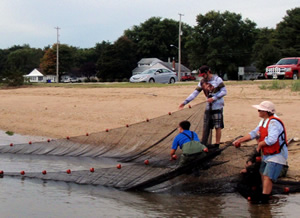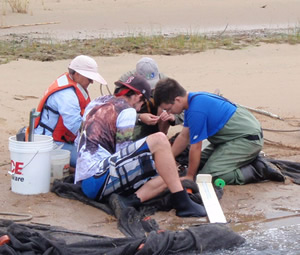  |
A Day on the Delaware River - Striped Bass Recruitment Survey |
|
by Gerald Wilders, Hourly Fisheries Technician
Bureau of Marine Fisheries
May 18, 2016
I arrive at Nacote Creek shortly after 6am and start loading the truck, trying not to forget my lunch and gear, and wait for the other crewmembers. Once everyone arrives, we hook up the boat and complete the boat/trailer safety check. Then everyone piles into the truck.
|
It's an enjoyable two hour drive with many stories shared to pass the time. Once we arrive at our destination, we launch the 20-foot Privateer into the Delaware River and head out to our first seining station. Our stations are fixed locations (beaches) located on the shores of NJ, Delaware and Pennsylvania. It's a beautiful day out on the river and the waves are less than a foot high. We couldn't have asked for better weather conditions.
The purpose of this study is to collect data to create abundance indices for young-of-the-year striped bass (age 0) and other juvenile fish species in the river. As we travel toward our first station, bald eagles are soaring in the sky in search of their first meal of the day. What a magnificent sight.
We proceed downstream to complete the seine hauls at a few stations before the tide gets too low. Unfortunately, the boat becomes stuck in the muck and we all pitch in to guide the boat out of the shallow water back into the current. Once we reach the first station, the boat is steered close to the shoreline enabling two crewmembers to jump out. They are responsible for securing one end of the 100-foot seine net while the rest of the net is set off the bow of the boat as it backs away from the beach. The boat creates a "U" shape to complete the set. This takes teamwork. The fish trapped in the net are brought to the shore by pulling the net onto the beach.
|
|
As we pull the net onto the beach, it gets caught on something under water. We wade out to reach the snagged net and almost get totally submersed trying to free the net. We think, "Could it be a root or tire?" It turns out to be a broken tree limb.
|
|
Once free, we see lots of movement in the bag of the net. We realize that an enormous catfish was caught. The catfish is measured and released quickly. Wow, what a whopper! The crew then enjoys sorting all the herring. We have to open the herring's mouths to determine whether they are blueback herring or American shad. This process is repeated a few hundred times. This has to be performed as quickly as possible in order to place the fish into buckets of water, so they don't die.
All species caught are sorted, counted, measured and sub-samples taken. Our identification list of species in the river includes approximately 100 species, and includes fish such as striped bass, white perch, a few species of catfish, anchovy species, silverside species, and river herring. It is tedious work, but very rewarding.
After the fish are sorted, any striped bass whose lengths are within a certain range have to have their scales taken for aging. This range changes throughout the season based on length estimates of age 0 fish. Collecting scale samples does not hurt the fish.
The last thing we do at each station is collect water quality with a YSI dissolved oxygen (DO) meter. This data is evaluated along with species data to show any species specific trends compared to the dissolved oxygen, pH, temperature, and salinity of the water. Now that the first station is done, I dare to anticipate what we will encounter at the next seven stations.
|
For information on past years' seining studies see the Studying the Delaware River articles on the Feature Articles page.
Back to A Day In the Life Of a Marine Fisheries Hourly
|


